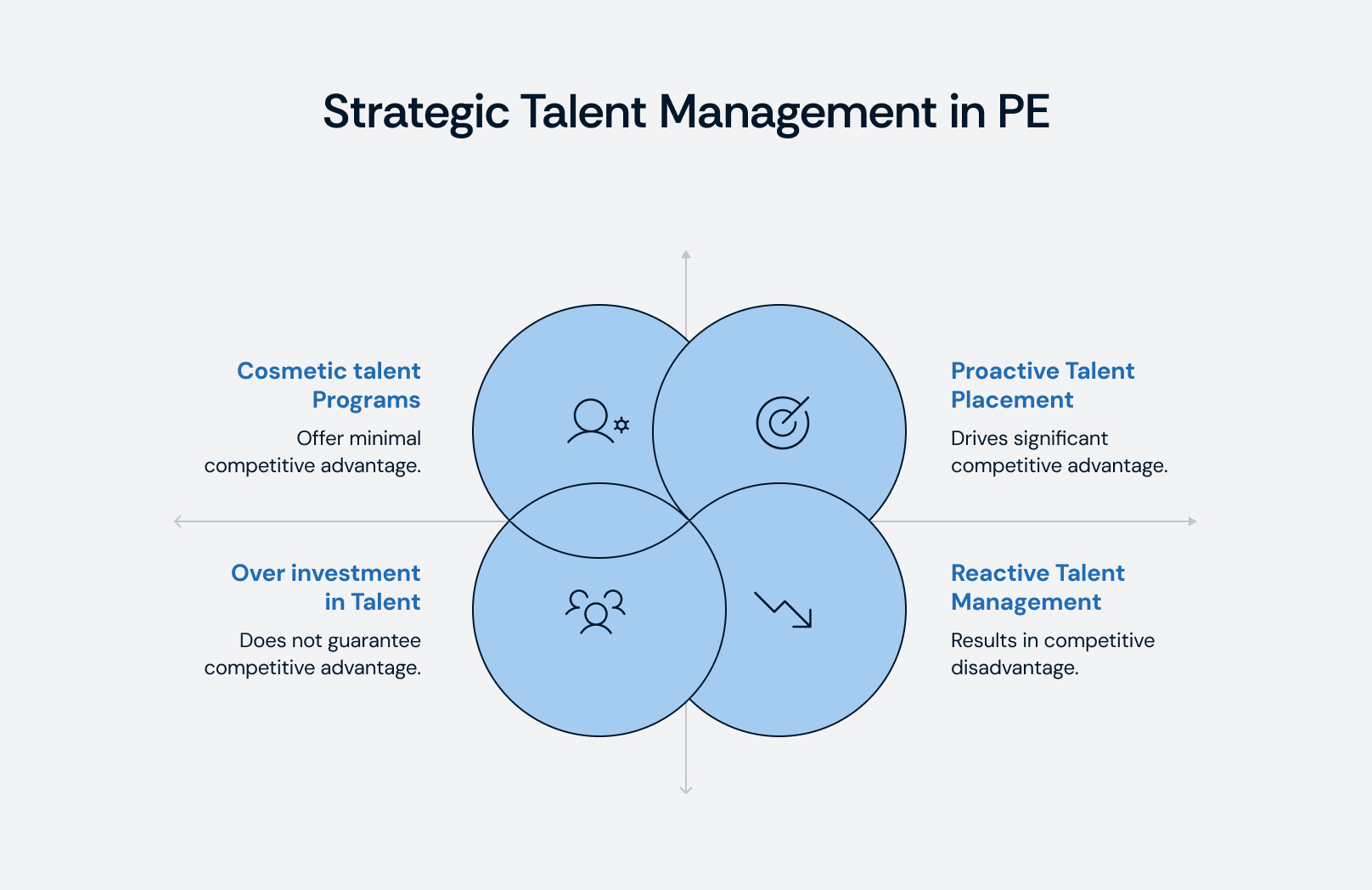The Talent Partner Advantage: Why Executive Search Expertise Is Becoming the Most Valuable Operating Capability
- Talent partners with executive search expertise are emerging as PE’s most strategic operating capability.
- Firms with dedicated talent leaders achieve faster CEO placements, lower turnover, and higher exit valuations.
- 73% of CEOs are replaced during ownership—yet 60% of those exits are unplanned, exposing assessment gaps.
- Top firms now integrate leadership diligence into IC processes and maintain 200–500 pre-vetted executives per sector.
- Time-to-placement drops from 6 months to 60–90 days, compounding into months of extra execution time across portfolios.
- Talent teams earn carry, sit on ICs, and drive measurable EBITDA impact—becoming core to fundraising narratives.
- Firms without these capabilities face slower execution, weaker LP confidence, and increasing competitive disadvantage.
The most potent competitive edge in private equity isn’t a proprietary deal network—it’s preemptive, precision talent placement. Top firms are embedding talent partners with executive search backgrounds to build institutional advantage across funds (JM Search).
The results are compelling:
- GPs attribute 53% of investment outcomes to leadership quality, according to internal analyses (McKinsey & Company).
- Firms that deprioritize talent face CEO turnover rates of 73%, with hold periods often extending as a result (JM Search).
- Leverage now drives only ~25% of PE value creation, as operating capabilities become the dominant return lever (McKinsey & Company).
What distinguishes the top-performing firms:
- They can place the right CEO in 60–90 days, compared to the 4–6 month industry average (Altios).
- They maintain 200–500 pre-vetted executives per sector (Bespoke Partners).
- They conduct CEO assessments during diligence, applying the same rigor used in financial modeling (Russell Reynolds Associates).
Early movers are pulling away:
- 77% of PE talent leaders were appointed in the last five years—and 50% in the last three (JM Search).
- 39% now come directly from executive search firms, embedding that expertise internally (Russell Reynolds Associates).
The question isn’t whether to invest in talent partner capabilities—it's how quickly you can catch up
From Afterthought to Existential Capability
The emergence of the talent partner role marks PE’s shift from viewing executive leadership as a secondary issue to recognizing it as a critical strategic lever. (JM Search)
Historically, firms treated executive talent reactively—call a search firm post-close when leadership failed. But by 2017–18, the data exposed this approach’s fatal flaw: 73% of portfolio CEOs are removed during ownership, and 58% are replaced within two years. (McKinsey & Company)
Worse: in four out of five cases, CEO removal came too late, derailing execution. (Wisnio)
Firms that only conducted superficial diligence later discovered their leadership lacked the capability to execute. These unexpected transitions consumed board cycles, dragged out hold periods, and compressed returns. (Medallion Partners)
When it became clear that 60% of CEO exits were unplanned, the industry could no longer ignore flawed diligence processes.
The structural change is clear. As leverage’s contribution to value creation has dropped (now ~25%), operational excellence has become the true engine of returns. (McKinsey & Company) But without strong leaders, ops plans go nowhere. Traditional diligence failed to evaluate leadership rigorously. Early-moving firms recognized this and began recruiting human capital capacity—not from general HR, but from executive search disciplines.
Search professionals bring what PE needed most: deep networks of C‑suite executives, assessment rigor, market intel, faster timelines, and credibility with portfolio management teams. (Caldwell)
Consultants provide frameworks, operators bring execution—but executive search offers structured talent processes that align precisely with what succeeds in PE.
This shift happened quickly. In a study of 80 large PE funds, 39% of talent partners were hired from executive search firms—making it the single largest feeder into the role. (Russell Reynolds) Expanding beyond that, 62% of talent partners had executive search experience within their last five roles. (JM Search)
In just the last five years, 77% of talent professionals have been appointed—and 50% in the last three years—marking this as a deep strategic realignment rather than a fad. (JM Search) Russell Reynolds also notes this momentum: early adopters are defining the benchmark. (Russell Reynolds)
The competitive consequences are already visible. As firms with integrated talent functions deliver faster CEO placements, lower turnover, and stronger exits, lagging firms must choose: build capacity or concede permanent disadvantage. LPs now interrogate human capital strategy in diligence, demanding detail on team structure, assessment methodologies, and tracked impact. (Russell Reynolds)
Thought leadership from McKinsey, Bain, Russell Reynolds, and others has elevated talent from HR support to strategic priority. (Equilar)
Now, roughly 60% of mid-to-large-cap funds maintain formal talent teams—up from almost none a decade ago. (Russell Reynolds)
Yet that statistic hides a deeper divide: many are cosmetic. The 40% of funds still lacking mature talent functions (JM Search) face shrinking margins—not just in deals, but in recruiting future leaders.
Talent gravitates to platforms where it can succeed. The strength of early-movers compounds advantage; late entrants struggle to catch up.

The Executive Search DNA That Creates Competitive Advantage
The dominance of executive search backgrounds among PE talent partners isn’t random—it reflects capabilities that directly tackle private equity’s toughest talent challenges. (JM Search)
Understanding why PE firms gravitate toward these professionals shows what separates surface-level “talent work” from genuine capability—and what skills firms should prioritize when building their teams.
Network Building & Activation
Executive search pros spend decades cultivating trusted relationships with CEOs, board members, and senior executives—not as transactional contacts but as long-term advisors. (Spencer Stuart)
They bring networks of 200–500 pre-vetted executives per sector, ready to be deployed. (Bespoke Partners)
That means when a portfolio company needs leadership, they can present strong slates in weeks, rather than months—sometimes during the acquisition process itself. (Altios)
Assessment Rigor & Pattern Recognition
Search professionals use structured assessment tools—psychometrics, behavioral protocols, reference frameworks—not just resumes.
They know which traits matter under PE conditions: learning agility, high transparency under pressure, ownership mindset, and financial orientation. (McKinsey & Company)
Market Intelligence & Talent Insights
Talent partners with search roots understand compensation trends, talent mobility, and hidden executive potential. (Equilar)
During diligence, they assess whether the current management team is truly best-in-class, identify top alternatives, and estimate the timeline and cost of a leadership upgrade. This insight directly informs investment decisions.
Speed, Discipline & Process Mastery
In PE, time is value. Seasoned search pros run rapid hiring workflows—parallel candidate tracks, fast reference checks, streamlined offer processes.
They reduce time-to-fill for CEOs from 4–6 months to 60–90 days—or even faster in urgent situations. (Altios)
For a 10-company portfolio with 71% CEO turnover, that compresses 12–18 months of cumulative downtime. (Harvard Law Forum)
Credibility with Executives
Search professionals speak the language of leadership. They build trust fast with CEOs and C-suite leaders—especially critical post-acquisition. This trust smooths leadership transitions and ensures that talent partners are seen as value-add collaborators, not enforcers. (JM Search)
Beyond Search: Strategic Advisory
Elite talent partners do more than place executives—they:
- Advise CEOs on value creation priorities
- Help design org charts and succession plans
- Connect teams with external advisors
- Prepare talent narratives for exit processes
But this advisory muscle must be built. It demands fluency in PE economics, operational drivers, compensation models, and change management strategy.
The most effective talent partners often blend search experience with operating or consulting backgrounds—a growing segment that now makes up 27% of PE talent partners. (JM Search)
The 200-500 Executive Network as Force Multiplier
The biggest competitive advantage a seasoned talent partner delivers is an activated executive network that transforms how portfolio company hiring operates. The difference between a Rolodex and a force‑multiplying network lies in depth of relationships, rigorous vetting, and systematic activation.
Network Scale & Structure
Top firms cultivate 200–500 deeply vetted executives per sector focus—not superficial contacts but trusted relationships. (Bespoke Partners)
They segment networks by function (CEO, CFO, COO, CTO, CRO) and industry verticals to ensure rapid fit.
When a software portfolio company needs a CFO, the talent partner can immediately identify 3–5 pre‑vetted candidates.
Rigorous Vetting (Pre‑Demand)
- 10+ back‑channel references per candidate—focusing on behavior, stress performance, weaknesses, and real performance.
- Psychometric or behavioral assessments to test fit in PE context.
- Deep conversations on motivation, compensation expectations, geography, trade-offs.
- Background verification and validation of track record.
Because of this pre‑vetting, networks become deployable rather than aspirational.
Speed & Deployment Advantage
- Instead of a 4–6 month search, these networks allow slates in days. (Altios: Exec Search Process Timeline)
- Senior executive placements often close in 60–90 days vs. months.
- In urgent situations, interim executives can be deployed in 3–5 days.
Financial & Execution Impact
In a $200M EBITDA company:
- With a network: shortlist in 2 weeks, offer by day 45, onboard by day 90.
- Without: external search cycles (sourcing, screening, negotiating) span 6+ months.
That time advantage compounds—over a 5–7 year hold, it equates to 6–12 months of execution lead per company.
Quality & Fit Edge
Pre-vetted candidates:
- Ramp ~10–15% faster
- Better cultural and strategic alignment
- Lower turnover
- Inspire greater board confidence
Referral‑based and network‑sourced hires tend to outperform traditional methods.
Tech & Infrastructure for Scale
To maintain this network at scale, leading firms use:
- ExecAtlas for executive relationship intelligence. (ExecAtlas Private Equity)
- CRM & TRM platforms (e.g. Thrive TRM, Crelate, Loxo) to support ongoing engagement and mapping.
Strategic Deployment in Deals
This network becomes both a competitive weapon and operational insurance:
- In auctions, firms can pitch succession capability as part of their deal
- In founder-led deals, being able to offer leadership continuity increases seller confidence
- The network ensures talent gaps don’t become value destruction points, and differentiates the bidder. (Russell Reynolds Associates)
CEO Assessment During Diligence Becomes Non-Negotiable
The evolution of CEO and C‑suite assessment from optional to mandatory in PE diligence reflects recognition that leadership quality is often the single biggest determinant of outcome. The shift accelerated once data made superficial reviews untenable, forcing firms to apply as much analytical rigor to executives as to financial models.
Research across thousands of PE investments shows:
- 73 % of portfolio company CEOs are replaced during the investment lifecycle.
- 58 % of replacements occur within the first two years.
- 60% of all CEO exits are unplanned, despite months for diligence. (McKinsey & Company)
- Only 15 % of transitions occur immediately post‑close—meaning 85 % arrive too late, after strategic stalling and cultural decay. (Wisnio)
The costs are severe:
- Replacement expenses often reach 200 % of departing CEO compensation when factoring recruiting fees, severance, lost productivity, and learning curve.
- Search timelines consume 4–6 months, during which companies can drift without direction.
- 82 % of unplanned transitions extend hold periods and compress IRR. (Medallion Partners / Cowen Partners)
- Leadership effectiveness is often credited with 30 % of valuation impact, and 15 % of financial performance. (Medallion Partners)
Top firms have responded with pre-deal, rigorous assessment frameworks that flag gaps early and enable corrective action. (Wisnio)
Best practices include:
- Personality & behavioral assessments (e.g. Hogan Leadership instruments) measuring stress response, derailment risk, values alignment, and executive traits. (Sheer Velocity)
- Structured behavioral interviews tailored to test real-world performance: managing under pressure, board conflict, rapid scaling, failure recovery. (Hunt Scanlon Media)
- Dynamic “if/then” interview paths, e.g. probing transparency under pressure if assessments flag risk.
- Enhanced, forensic reference checks, going beyond standard references to 10+ backchannel interviews (board members, investors, direct reports) focusing on patterns not just resumes. (Bespoke Partners / RMA Search Firm)
- Extending evaluation to the full executive team—CFO, COO, CTO, CCO—to validate team strength, complementary skillsets, succession readiness, and depth.
This approach elevates talent evaluation to a core investment discipline. Leading firms now require IC memos to include a management team assessment section, with data, gaps, and mitigation plans alongside financials. (JM Search)
Talent and operating partners actively participate in IC’s, influencing deal decisions—or even vetoing deals where leadership risk is too great. (JM Search / LinkedIn)
A typical division of roles:
- Internal talent partners: define assessment frameworks, interpret results in light of deal thesis, maintain CEO/leader relationships across the hold period.
- External specialists: provide deep psychological assessment, run confidential reference checks, offer market benchmarking, and scale capacity during high activity periods. (Sheer Velocity / Hunt Scanlon Media)
Though assessment costs (often $50K–$200K for comprehensive reviews) may raise eyebrows, they are minimal relative to the downside: CEO replacement, extended holds, value leakage, and misaligned leadership. Firms investing aggressively in leadership evaluation consistently outperform peers, posting faster value creation, lower turnover, and smoother exits.
Why This Becomes Your Secret Weapon
In private equity, most firms still compete on sourcing and financial engineering. But the most durable edge—the one that compounds quietly across deals, fund cycles, and firm reputation—is talent.
A well-built talent function behaves like any true capability: it takes years to develop, can’t be bought off the shelf, and creates network effects that widen the performance gap over time. Early movers pull away. Late adopters struggle to catch up.
The firms that get this right—like Russell Reynolds—begin winning before deals even close. In competitive auctions, they show up with pre-vetted executive candidates, articulate clear succession plans, and offer founders operational confidence, not just capital. That matters—especially in founder-led exits where trust trumps top-dollar offers.
Over time, the advantage compounds. Execution accelerates. Portfolios scale faster. LPs notice. And while traditional firms are still staffing post-close leadership searches, the firms with embedded talent partners are already realizing EBITDA gains.
The talent edge is real. And in today’s environment, it’s the difference between a good firm—and one that wins consistently.
The Imperative and Investment Required
Private equity firms face a binary choice: invest meaningfully in talent capabilities—or accept the limitations of outsourcing and episodic engagement. The most dangerous path is the middle ground: claiming a talent focus without backing it with resources. Cosmetic programs waste capital, erode credibility with LPs, and fail to deliver performance.
What Real Investment Looks Like
For firms choosing to commit, the blueprint is increasingly clear:
- Mid- to large-cap firms ($1–5B AUM): Typically field 3–8 full-time talent professionals, supported by 15–30 part-time advisors.
- Mega-funds ($10B+ AUM): Build 50–100+ person ops teams, including 10–15 partners focused on talent.
- Lower mid-market ($250M–$1B AUM): Leaner teams (1–2 operators) act as super-generalists, supported by selective external experts.
Compensation Reflects Strategic Role
Talent leaders are compensated like true partners—not support staff. According to Russell Reynolds, base salaries range from $350K–$750K, with performance bonuses from $150K to $1M+, and meaningful carry (10–15% pool, with top partners receiving 1–3% individually). Total operating capability budgets run 5–10% of management fees—$5M to $40M annually.
The Talent Partner Profile
Top-performing talent partners come from executive search—39% directly, and 62% with search in their background (Russell Reynolds). Many combine recruiting experience with operating credibility. The highest performers bring 15–20 years of experience, CEO/CxO placement records, board-level networks, and deep sector expertise.
Integration Is the Differentiator
Organizational structure determines ROI. In best-practice firms:
- Talent leads participate from pre-LOI through exit.
- Management assessments inform IC materials with real influence.
- Talent leaders activate post-close roadmaps immediately—not six months in.
- Ongoing engagement with CEOs ensures continuity and early intervention.
Critically, these partners have investment committee seats, independent authority, and the ability to shape deal terms when talent risks emerge.
Tech, Tools, and Tracking
Modern talent platforms mirror CRM systems—tracking executive networks, refreshing bios, flagging engagement touchpoints, and archiving assessment data. Leading firms use tools like the Hogan Leadership Series for objective evaluation, Sheer Velocity for reference rigor, and structured team diagnostics to assess more than résumés.
They also track performance with private-equity-level precision:
- Planned vs. unplanned CEO/CFO turnover
- Time-to-fill for critical roles
- Retention benchmarks
- Culture and engagement metrics
- EBITDA and valuation delta tied to talent initiatives
Build vs. Buy: The Math Wins
Over a 5-year hold, a 10-company portfolio with 71% CEO turnover may spend $1.5–$3.5M on external search. Internal talent partners cost $2.5–$4M over the same period but deliver faster placement, better fit, and broader strategic value—from pre-deal assessment to post-close org design. The ROI is clear.
Timelines That Matter
- 6–12 months: Hire, onboard, and integrate a core team
- 18–36 months: Build 200–500 executive relationships per sector
- 12–24 months: Institutionalize processes and roadmaps
- 3–5 years: Reach full maturity comparable to leaders like KKR, Blackstone, or Vista Equity Partners
The Window Is Closing
Today, 40% of mid- to large-cap funds still lack a dedicated talent team. But the industry is shifting:
- Sellers prefer buyers with talent credibility
- LPs demand human capital sophistication
- Top talent partners go to established platforms
- Execution gaps widen as competitors pull ahead
The Strategic Divide
Firms that treat talent as core invest accordingly—carried interest, IC participation, modern infrastructure, and full lifecycle integration. Others keep it reactive and outsourced.
The worst outcome? Pretending to care, without the investment to back it up.







